Give Poles a Chance

For roamers, wanderers, and athletes alike, the truth regarding efficiency of movement over terrain for long distances is no secret: If you want to go farther, faster, with less pain and fatigue, use trekking poles. Those who have never tried poles or have yet to master the proper technique might be skeptical, but scientific studies validate this common hiker knowledge. Beyond the physical benefits, the variety of alternative uses make poles essential gear for anyone spending time in the wilderness.
Bipedalism
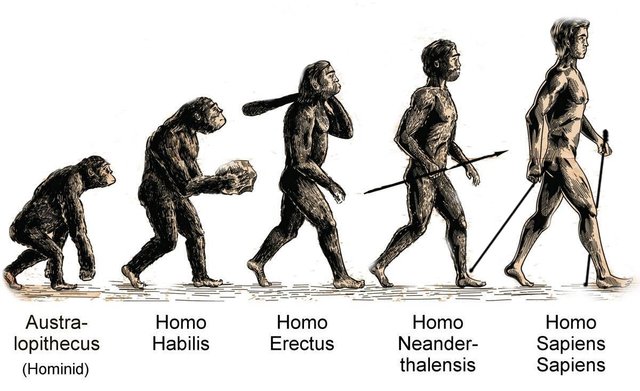 Source | Diagram showing the evolution of bipedalism from an early hominid knuckle-walker (left) to modern day humans (right), with poles added.
Source | Diagram showing the evolution of bipedalism from an early hominid knuckle-walker (left) to modern day humans (right), with poles added.
To better understand why poles are a natural walking aide, we must think about the evolution of man. Humans have evolved an upright and bipedal form of primary locomotion unique amongst the great apes. Other animals such as birds and kangaroos, as well as apes like bonobos, chimpanzees, orangutans, and gorillas can walk (or hop) bipedally for short distances, but for chimpanzees and other apes, quadrupedal motion is far more efficient. Interestingly, a different study confirms that a bipedal walking motion in humans is approximately 75% more efficient than a knuckle-walking quadrupedal motion in chimpanzees.
 Source | A look at the skeletal differences among humans and other apes in a bipedal pose.
Source | A look at the skeletal differences among humans and other apes in a bipedal pose.The skeletal evolution associated with the transition from quadrupedalism to bipedalism in humans has made walking upright much more energy efficient. Namely, changes to the size and position of the feet, legs, knees, hips, spine, skull, and arms all make trodding on two feet easier for humans. During bipedal motion our arms instinctively swing to help maintain balance and preserve linear momentum. Could this arm swing also be a natural throwback to the days of knuckle-walking?

Source | A natural progression in the evolution of bipedal walking must involve poles and a pack, right?
Physical Benefits
As an extension of the arms, poles can be used for a variety of purposes. The most apparent is to essentially act as an additional set of legs. Poles provide a way to transfer some of the load from the upper body to the ground without needing the stooping and inefficient gait of a knuckle-walker. They further engage the arms, shoulders, back, chest, and abs in the process of hiking. When hiking without the help of poles, all of the body and pack weight is transferred through the hips, knees, and legs. A study from 1981 reveals that using poles reduces stress on the knees by as much as 20%.
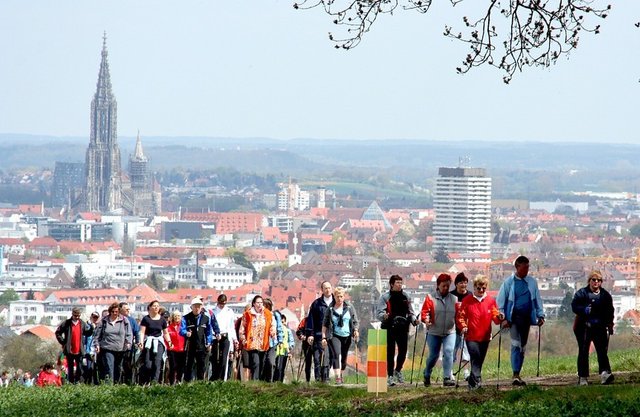 Source | A group of Nordic walkers summit a hill in an urban park using poles. Can you name the city? (I cannot)
Source | A group of Nordic walkers summit a hill in an urban park using poles. Can you name the city? (I cannot)Engaging in a full-body workout ensures that strength grows in a more balanced way. Though more energy is burned while using poles, due to a greater number of muscles being engaged, pole users report feeling less fatigued than those who hiked the same terrain without poles. This is likely from the reduced load on the legs and knees when engaging the arms. There is even a social movement of urban walkers who use poles to get a better workout. The hobby, known as Nordic walking, is commonly recognized as a good way for people (young and old) to improve overall muscle strength. Keeping the hands at a higher level relative to the heart during pole use also helps with blood circulation and prevents unpleasant swelling in the hands.
Pole Technology

Source | The main components of a collapsible trekking pole, with labels.
Pole Techniques
The way that an experienced hiker uses poles varies considerably based on individual gait, build, and stride, load weight and distribution, hiking speed, and terrain. There is no specific technique that works for each individual, or even a single technique that an individual can use in all situations.
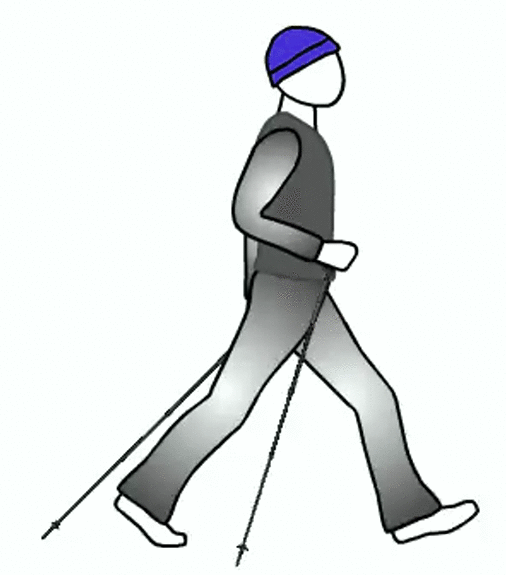 Source | Animation showing one of the proper ways to use poles, with the opposing arm and leg moving together.
Source | Animation showing one of the proper ways to use poles, with the opposing arm and leg moving together. As a general rule of thumb, on relatively flat terrain the arm should form a ninety-degree angle at the elbow when standing upright and holding the pole vertically. When powering up a local summit the poles should be slightly shorter than this, and slightly longer than this on the descent.
Some common techniques include moving both poles together with each step, moving one pole opposite the stepping leg, or moving one pole adjacent to the stepping foot. Personally, I often fall into a slower hybrid variation where one pole is placed after every 2 steps. This helps to create a sensation of 'rolling' across the ground and reduces unnecessary energy expenditure while still providing benefits.
Rhythm
One common use of poles is to help establish a natural hiking rhythm. Involving the arms in the process of hiking brings out the primal sensation of coasting across the ground like a four-legged animal in a rhythmic trot. In some ways, this repetitive rhythm can help induce a meditative trance that increases the peace and relaxation of the hiking experience. The rhythmic sound of poles clicking on the ground can help with zoning out and make hours of strenuous hiking seem like a walk in the park! This beat is often subconsciously integrated into breathing patterns for increased oxygen uptake and improved performance.
Stability
Hiking with a pack greatly alters the weight distribution of the upper body and can make it easier to lose balance. Couple this with traversing across miles of often rough terrain while fatigued in variable weather and the tendency to trip, stumble, and topple is greatly increased. Poles provide two additional points of contact with the ground, making any trip or stumble easily recoverable with a quick flick of the wrist. Poles also serve as a convenient object to lean on during short rests. 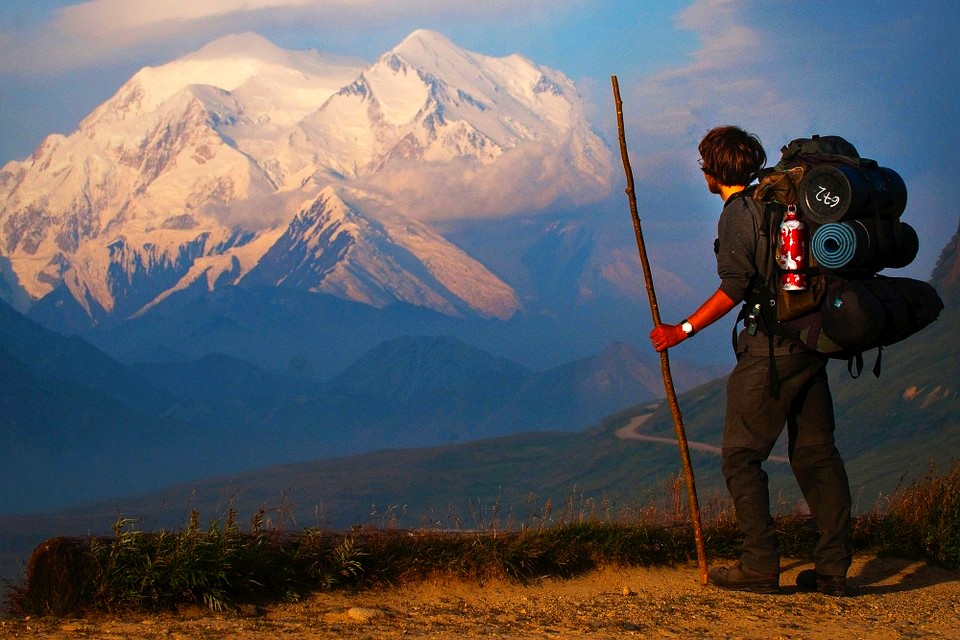 Source | A hiker rests on a traditional branch hiking staff, with a magnificent view of Mt. McKinley in Alaska.
Source | A hiker rests on a traditional branch hiking staff, with a magnificent view of Mt. McKinley in Alaska.
Speed
There is debate on the internet as to whether or not poles help hikers go faster. Some claim that on flat terrain they feel that poles are a burden and that their maximum speed is limited by how quickly they can move their arms. This seems more likely to be a case of poor technique, as most of the speed records for distance trails involve the use of poles. There are some speed records that are achieved without the use of poles, but these are usually short distances where people can essentially sprint up a trail carrying very little in the way of gear. For endurance records and serious mountains, poles are irreplaceable.
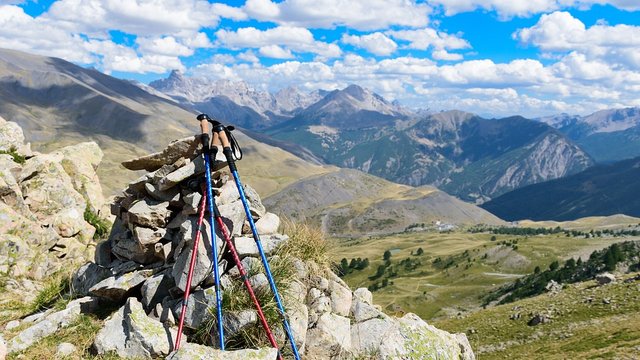 Source | Cork and foam grips on two pair of trekking poles leaned against a rock carin alongside a strenuous alpine trail.
Source | Cork and foam grips on two pair of trekking poles leaned against a rock carin alongside a strenuous alpine trail.
Safety
There are many situations that arise while hiking that can be made safer or more comfortable by using poles. One example is that of mud or rushing water – it is hard to tell how deep or stable these substrates are until they are tested. With the use of poles it is possible to probe the path ahead and safely 'test' the condition and integrity of mud, rock, or water without risking falling or getting injured!Another use that enhances comfort and safety while hiking is the removal of spiderwebs or other brush that blocks the path. The upward swing of a pole is usually enough to move any minor obstruction. When going through overgrown areas, poles can help to hold thorns and other annoying shrubbery back and prevent unnecessary scrapes and cuts.
Wildlife
Most animal encounters in the wilderness are not life-threatening. The majority of creatures are harmless and are likely aware of your presence long before you see them. Depending on the environment, there are a few species that have the potential to be deadly, but poles can help with these dangerous encounters. They can hold smaller creatures like snakes, wolves, and coyotes at a distance.
The biggest wildlife threat while hiking in the United States is suddenly encountering a bear; particularly a mother bear with her cubs, a hungry bear, or a male during mating season. Regardless of the bear species, the first response upon encountering a bear should be to stay calm and slowly move away. If it is a black bear that starts to approach curiously or acts aggressively, wave your poles wildly in the air and clack them together while screaming and jumping. This sudden transformation from a silent, stationary figure to a screaming, 15-foot-tall crazy monster is usually enough to surprise black bears and frighten them away.
 Source | A black bear mother and cub. Black bears are more common in most parts of the United States, and tend to be less aggressive than grizzly bears.
Source | A black bear mother and cub. Black bears are more common in most parts of the United States, and tend to be less aggressive than grizzly bears.
Acting like this is not recommended when facing a grizzly bear. The safest way to face a grizzly is by remaining still and being equipped with bear spray. If spray does not work and the grizzly bear continues to approach, try to climb a tree or lay face down on the ground while covering your head and neck with your hands and play 'dead'. The hope is that the bear loses interest before doing so much damage that you are no longer just playing! If the attack continues for a prolonged amount of time, use poles or anything else you can find as a weapon to attack the head of the bear. Fight, as your life depends on it!
Injuries
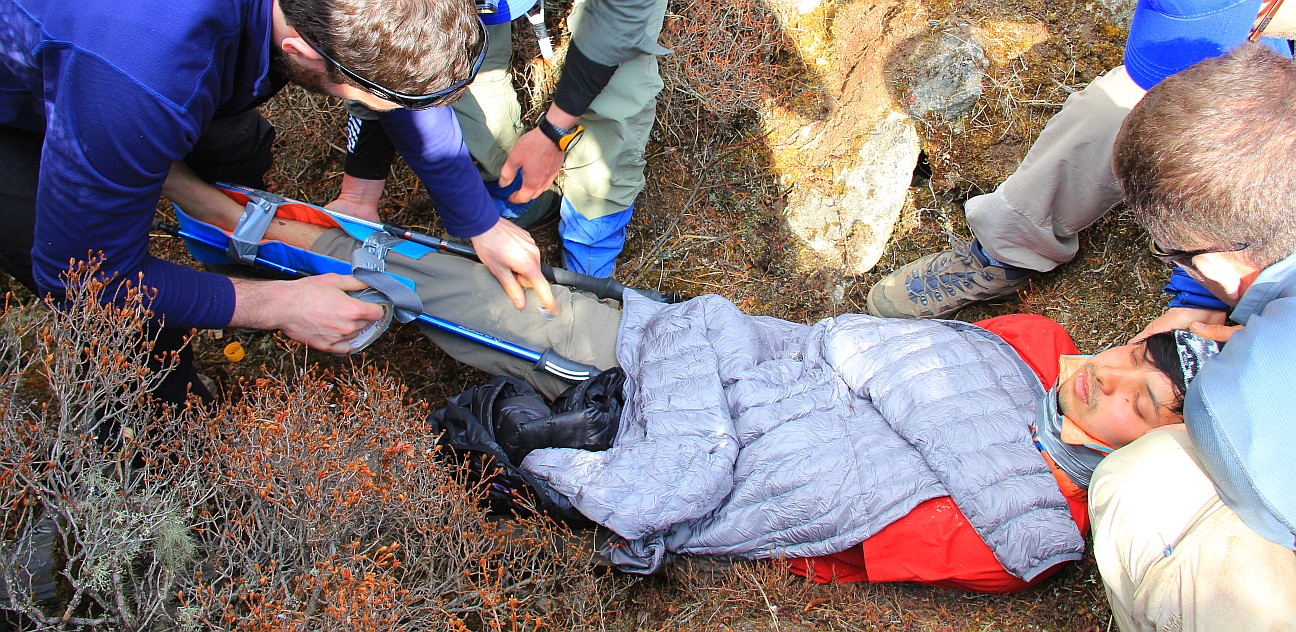 Source | Hiking poles being used with tape as an emergency splint to prevent a broken leg from moving.
Source | Hiking poles being used with tape as an emergency splint to prevent a broken leg from moving.
It is impossible to plan for everything that could go wrong while hiking away from civilization. Injuries and illnesses that are easily treatable by doctors become much more serious when the nearest town is 50 miles away and there are no roads nearby, nor cell phone reception. In the event of a foot, ankle, knee, leg, hip, or back injury, walking with poles can greatly reduce the stress on these parts and assist with a safe self-evacuation. If the injury is more severe, such as a broken leg, poles can be bound together across the injury to function as a makeshift splint. Some doctors warn against this practice for traction splints, but in an emergency it may bring some comfort to the injured.
Shelter
Poles can be used as part of an emergency or lightweight minimalist shelter in conjunction with tarp and cord. This works particularly well with adjustable poles that can be shortened to an optimal height in order to support the ends of the tarp. When inverted, the tip of the pole can be installed in the grommets of the tarp and a rope tied off to a tree, stake, or some other anchor point will produce a stable shelter. Several additional uses for poles have been reported with countless others (such as a monopod) yet to be commonplace!Drawbacks
As with all things, there are some drawbacks to using poles while hiking. The most obvious one is that your hands are no longer as free. Wrist leashes attached to most types of poles reduce the severity of this issue and also prevent accidental pole drops. Improper pole use can result in blisters on the hands or wrist injuries, but with practice these can be almost entirely avoided. The price of a nice pair of poles can be another deterrent, though the lower-end poles are quite affordable. If money is the largest factor, start with a good straight walking stick for free!
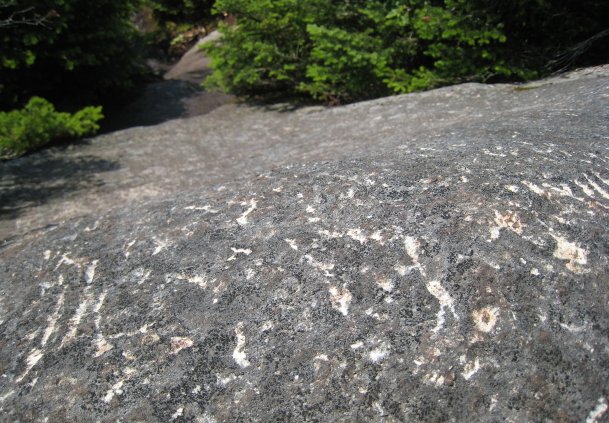 Source | Gouges in bedrock along a trail due to the carbide tips of hiking poles.
Source | Gouges in bedrock along a trail due to the carbide tips of hiking poles. Groups such as the Appalachian Trail Conservancy have considered the negative environmental impacts of pole use. They estimate that over 90% of thru-hikers use poles while hiking the AT. The main ecological and aesthetical concerns of pole use include destruction to trail bedrock, soil, and adjacent vegetation. Fortunately, these issues can be significantly reduced by using the blunt rubber tips that come with most poles and removing the optional snow baskets except when actually hiking through snow.
Some people do not like the sound that poles make, though personally it helps me establish a rhythm. Others might take issue with the fact that using poles burns more energy and is therefore technically less efficient than hiking without. Realistically, most hikers can appreciate increased strength and decreased fatigue, and burning a few extra calories while adding muscle is often a primary goal for exercising in the first place!
One remaining issue related to poles is the extra weight that they add, especially when not in use. Though poles are effective on most terrain, extremely steep and rocky climbs are actually impeded by pole use. In these situations, it is safest for the hands to be free for increased contact with the rock. Fortunately, most poles are fairly lightweight and can be collapsed for easy storage, rendering these arguments somewhat trivial.
In Conclusion
We have evolved from quadrupedal apes into bipedal humans. Though less energy is expended walking on two feet, there are many reasons to carry and use poles while hiking. Dispersing the weight and forces associated with hiking through two additional points of contact allows more muscles to be used, and stress on the legs and knees are greatly diminished. Collectively, hikers have come to an overwhelming consensus regarding the beneficial nature of poles and scientific studies have reaffirmed this shared wisdom.

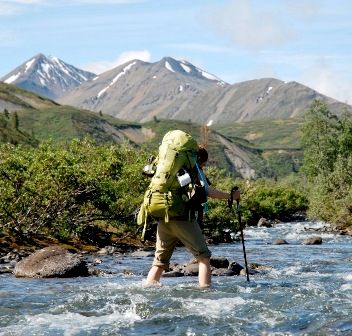
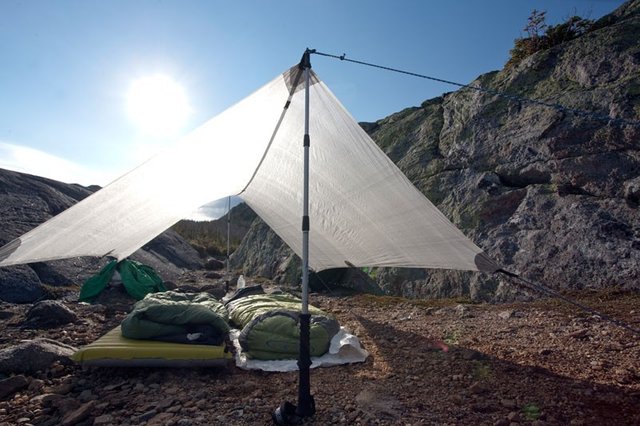
Nature always wears the colors of the spirit.
Very interesting! I have never thought of this concept, thank you for sharing!
Thanks, glad you found it interesting!
Keep up the good work, really excited for future posts!
What a great post! I'm a beginner at hiking and never really used poles before. But, happy to read about all the benefits. Love hiking and rather do it safely. The thing about them is that not everyone knows how to use them the right way. In my case, sometimes I feel they help a lot with the weight on my back, but sometimes I feel they're just bothering, cause' I think it depens on the trail. How to manage that?
Thank you for checking out my post, I'm glad you liked it! In some terrains they can be a burden, but in those cases just stow the poles on your pack until they become useful again. The more you use them, the more comfortable they will become!
That's true. I will plan in investing in a pair since I really love hiking. I love your blog and the quality of your posts, love that you are a geologist too, since I'm a former geophysics student. Will follow you, no doubt.
Hello @gra Salam kenal kawan maukah you become my friend and help me vote @
Nice post! Personally, I never hike without my sticks! :)
I have however never thought about the potential environmental issues. Good food for thoughts and chat (during my next hike) :)
Thank you! The environmental concerns are something that I have noticed firsthand on more popular trails. The damage along narrow sections of high-traffic routes can be rather distracting once you start looking for it. I think that rubber tips go a long way toward reducing the problem, but they have their own drawbacks (such as becoming 'trail litter' when they inevitably fall off). Let me know if you and your hiking buddies have any revelations!
posting anda sangat menarik, saya suka postingan anda, karena bisa menambah wawasan saya, mudah-mudahan ke depan bisa memberikan postingan yang lebih baik, jadi saya bisa mengetahui banyak hal dalam hidup saya, terima kasih banyak. dan juga semoga bermanfaat bagi teman berjanggut lainnya.
This is a really awesome post! I love all the examples you gave, and even dove into the history of how we have evolved! Thanks for this! Definitely looking forward to following you! Gonna have to try walking with poles!
I appreciate your praise! Best of luck trying out poles!
Very useful and quality post. Thanks
Hello, great work, i liked your post and reward it with upvote.
I'm running budget proposal campaign on Steemit for funding my future STEEM Windows and Android app - STEEMER. If you would like to contribute, please visit my post for details: https://steemit.com/utopian-io/@cryptomonitor/steemer-your-future-steem-blockchain-transactor-windows-android-app-funding-update-23-12-2017
when one does something with the soul, he created a river of joy able to move mountains